The Water Hole Read online
THE
WATER
HOLE
A Western Story
by Zane Grey
Copyright © 2014 by Zane Grey, Inc.
Copyright © 2014 by Blackstone Publishing
All rights reserved.
Published by arrangement with Golden West Literary Agency
October 2014
Second Edition
First Ebook Edition
Trade: 978-1-4815-2849-8
Library: 978-1-4815-2848-1
Foreword
by Jon Tuska
Zane Grey’s public image was that of a family man. He fathered three children with his wife, Lina Elise, known familiarly as Dolly. First born was his son Romer, followed by his daughter Betty, and finally by a second son Loren. Loren would pursue a career in psychology, earning a doctorate, teaching and writing on the subject. It was Loren Grey who pointed out to me that his father’s fascination with polygamy had its origin in his own personality. Zane Grey was highly critical of Mormonism in 1912 in Riders of the Purple Sage: The Restored Edition (Five Star, 2005) in which all three of the principal female characters, although they don’t know it, are actually half-sisters and daughters of the same Mormon patriarch. By 1915 when Grey wrote The Desert Crucible (Five Star, 2003), the sequel to Riders of the Purple Sage, his attitude toward Mormon polygamy had somewhat softened. He observed in this novel: “One wife for one man—that was the law. Mormons broke it openly. Gentiles broke it secretly…Unquestionably the Mormons were wrong, but were not the Gentiles still more wrong?”
Grey’s lifestyle changed with increasing affluence and popularity. Two of his girlfriends went along in the Grey party when he visited Nonnezoshe, the great Rainbow Bridge of the Navajos, for the first time. Afterward girlfriends almost invariably accompanied him in his travels, a situation that deeply wounded Dolly. Yet his numerous affairs with women seemed to inspire him in his Western romances as much as his discoveries of magical places in the wilderness. Mildred Smith, called familiarly Millicent by Grey, became his personal secretary. She was often attired as actress Lois Wilson would be when she brought Grey’s heroines to the screen in Paramount films of the 1920s, and at times Smith went without Zane Grey on location with the film crews in Arizona. It is known that Smith began editing and contributing plot ingredients and ideas for how characters behaved in Grey’s fiction as early as 1918 in War Comes tto the Big Bend (Five Star, 2012). Dolly in her correspondence with Grey often warned him against permitting Mildred to influence his writing. Grey tended to declare her contributions minimal and on one occasion confessed to Dolly: “I did take M’s advice about a little of the rewriting. To be honest it helped me to get her point of view.”
There was a degree of secrecy in Grey’s dealings with women. He was attracted primarily by their beauty. They would communicate by letters with him that were written in code. Grey also used code to record diary entries about what he once described to Dolly as his “inamorata”. His daughter Betty recalled to me an incident in which her father remarked to her mother within Betty’s hearing that it was Mildred’s express desire that he should divorce Dolly and marry her. Indeed, it was this statement that prompted Dolly to move into her own bedroom and not, as Frank Gruber wrote in Zane Grey: A Biography (World, 1970), because Grey “worked late at his writing and did not want to awaken Dolly upon retiring.” Dolly’s defense was to make a life for herself, but she organized Zane Grey, Inc., and acted as conservator for the money Grey’s work earned even after Grey’s death.
Initially Mildred lived in Grey’s home on Catalina Island, before moving into the smaller replica of that home Grey had designed for her on the mainland. If Fay Larkin was a sealed wife of a Mormon kept hidden in seclusion in The Desert Crucible, Mildred Smith was no less so in this home Grey gave her. Through the many years of typing and editing Grey’s manuscripts, Smith discovered she had literary ambitions of her own. In the early 1920s she collaborated with Grey on four stage plays. With the exception of the first of these, the plays all had contemporary settings, and traces of Mildred’s work can certainly be detected in all of the contemporary stories that Grey wrote during the fifteen years Mildred was with him. The first of these collaborative stage plays was Amber’s Mirage. When Grey was unable to find any theatrical manager to produce it, he turned it into a short novel, “Amber’s Mirage”, a three-part serial published in Ladies Home Journal (5/29-7/29) and collected in restored form in Rangle River: Western Stories (Five Star, 2001). It was at Arizona movie locations that Mildred began her own Western romance with a contemporary setting. When no publisher could be found to accept it, Grey rewrote the story and published it under his own name as “Desert Bound”, a six-part serial appearing in McCall’s (12/25-5/25).
The second of the unproduced and unpublished stage plays on which Millicent Smith and Zane Grey collaborated that Grey subsequently turned into a magazine serial was The Courting of Stephen. The play is a romantic farce that shows how the principal female character turns the tables on the man she wants to marry, using variations of Stephen’s own courtship techniques. The Water Hole was the result, rendering into English the Navajo word Beckyshibeta for an area that conceals below ground an ancient Indian kiva and at the same time is a source for water in the midst of the surrounding desert. The holographic manuscript for this serial is in Zane Grey’s handwriting, so it is impossible to determine the extent to which Smith contributed to this version, but there is no question that the heroine was her creation and Grey did what he could to embody Mildred’s personality even more into the Cherry Winters character in the story. When “The Water Hole” appeared as a twelve-part serial in Collier’s (10/8/27-12/24/27), all of the character names had been changed. When the serial was posthumously published as Lost Pueblo by Harper & Brothers as the 1954 Zane Grey novel, the text was that of the magazine version, and so the numerous excisions the magazine had made from the text as well as the altered character names were retained. The text published here restores what Zane Grey wrote including all the characters as he originally named them. How the enchantment of the desert could change a person physically and spiritually for the better was a theme for Zane Grey certainly as old as Desert Heritage (Five Star, 2010), written in 1909. Whether Grey should have tried to write a contemporary 1920s romantic farce, as Mildred continued to urge him to do, and how enjoyable the result was are issues best left to the judgment of the reader. All I can say is that The Water Hole is unlike anything else Zane Grey ever published.
One
Cherry Winters did not see anything of Arizona until morning. The train had crossed the state line after dark. New Mexico, however, with its bleak plains and rugged black ranges, its lonely reaches, had stirred in her quite new sensations. Her father had just knocked upon her door, awakening her at an unusual hour. She had leaped at her father’s casual proposal to take a little trip West with him, but it had begun to have a rather interesting significance to her. And Cherry was not so sure how she was going to take it.
They had arrived at Flagstaff late in the night, and Cherry had gone to bed tired out. Upon awakening this morning, she was surprised at an absence of her usual languor. She appeared wide-awake in a moment. The sun streamed in at the window, very bright and golden, and the air that blew in with it was sharp and cold.
“Gee! I thought someone said it was springtime,” said Cherry as she quickly got into slippers and dressing gown. Then she looked out of her window. Evidently the little hotel was situated on the outskirts of town. She saw a few scattered houses on each side, among the pine trees. There were rugged gray rocks, covered with vines and brush. The pines grew thicker and merged into a dark green forest. In the distance showed white peaks against the deep blue of sky. Cherr
y had an inkling that she was going to like this adventure.
She did not care to admit it, but, although she was only twenty years old, she had found a good deal too dull at her home in the East. Serious thought appeared to be something she generally shunned, yet to her, now and then, it came involuntarily.
While she dressed she pondered upon the situation. She had never been West before. After college there had been European travel, and then the usual round of golf, motoring, dancing, with all that went with them. She was well aware of her father’s dissatisfaction with her generation. Despite his attitude he had seldom interfered with her ways of being happy. This trip had a peculiar slant, now that she scrutinized it closely. They were to meet a young archaeologist here in Flagstaff, and probably arrange to have him take them to the Grand Cañon and other scenic places. Cherry had become acquainted with him in New York, where he had been lecturing on the prehistoric ruins of the Southwest. Stephen Heftral had struck Cherry as being different from the young men she played about with, but, insofar as her charms were concerned, he was as susceptible as the rest. Heftral had never betrayed his feelings by word or action. He had seemed a manly, quiet sort of chap, college-bred, but somewhat old-fashioned in his ways, and absorbed in his research work. Cherry had liked him too well to let him see much of her. Not until she and her father had been out West did he mention that he expected to meet Heftral. Then she was reminded that her father had been quite taken with the young archaeologist. It amused Cherry.
“Dad might have something up his sleeve,” she soliloquized. “I just don’t quite get him lately.”
Cherry found him in the comfortable sitting room, reading a newspaper before an open fireplace. He was a well-preserved man of sixty, handsome and clean-cut of face, a typical New Yorker, keen and worldly, yet of kindly aspect.
“Good morning, Cherry,” he said, folding his paper and smiling up at her. “I see you’ve dispensed with at least some of your make-up. You look great.”
“I confess I feel great,” Cherry responded frankly. “Must be this Arizona air. Lead me to some lamb chops, Dad.”
At breakfast Cherry caught a twinkle in her father’s fine eyes. He was pleased that she appeared hungry and not inclined to find fault with the food and drink served. Cherry felt he had more on his mind than merely giving her a good time. It might well be that he was testing a theory of his own relative to the reaction of an oversophisticated young woman to the still primitive West.
“Heftral sent word that he could not meet us here,” remarked her father. “We will motor out to a place called Mormon Cañon. It’s a trading post, I believe. Heftral will be there.”
“We’ll ride into the desert?” Cherry asked with enthusiasm.
“Nearly a hundred miles. I daresay it will be a ride you’ll remember. Cherry, will you wear that flimsy dress?”
“Surely. I have my coat in case it’s cold.”
“Very well. Better pack at once. I’ve ordered a car.”
“Are there any stores in this burg? I want to buy several things.”
“Yes. Some very nice stores. But hurry, my dear. I’m eager to start.”
When Cherry went out to do her shopping, she certainly wished she had worn her coat. The air was nipping, and the wind whipped dust in her face. Flagstaff appeared a dead little town. She shuddered at the idea of living there. Limiting her errands to one store, she hurried back toward the hotel. She encountered Indians who despite their white man’s garb were picturesque and thrilling to her. She noted that they regarded her with interest. Then she saw a Mexican boy leading several beautiful, spirited horses. There was nothing else in her brief walk that attracted her attention.
In a short time she was packed and ready for her father when he came to her room. He acted more like a boy than her erstwhile staid and quiet parent. The car was waiting outside.
“We’re off,” declared Mr. Winters with an air of finality. And Cherry bit her tongue to keep from retorting that he could speak for himself.
Soon they left the town behind and entered a forest of stately pines, growing far apart over brown-matted, slow-rising ground. The fragrance was similar to that of Eastern forests, except that it had a dry, sweet quality new to Cherry. Here and there the road crossed open ranch country, from which snow-clad peaks were visible. Cherry wondered why Easterners raved so about the Alps when the West possessed such mountains as these. She was sorry when she could see them no more. Her father talked a good deal about this part of Arizona, and seemed to be well-informed.
“Say, Dad, have you been out here before?” she asked.
“No. Heftral talked about the country. He loves it. No wonder!”
Cherry made no reply, and that perhaps was more of a compliment than she usually paid places. The road climbed, but neither the steepness nor the roughness of it caused the driver any concern. Soon the car, entering thicker forest, dark and cool, reached the summit of a ridge and started down a gradual descent, where the timber thinned out, and in a couple of miles failed on the edge of the desert.
It was Cherry Winters’s first intimate sight of any desert. She felt strongly moved, yet whether it was in awe or wonder or reverence or fear, or a little of each combined, she could not tell. The sum of every extended view she had ever seen, in her whole life, could not compare with the tremendous open space before her. First it was silver and gray, dotted with little green trees, then it sloped off yellow and red, and ended in a great hollow of many hues, out of which dim purple shapes climbed.
“That must be the Painted Desert, if I remember Heftral correctly,” said her father. “It is magnificent. Nothing in Europe like it. And Heftral told me that this is nothing compared to the Utah country two hundred miles north.”
“Let’s go, Dad,” Cherry replied dreamily.
From that time on the ride grew in absorbing interest for Cherry, until she was no longer conscious of reflection about her impressions. The Little Colorado River, the vast promontory of Kishlipi, the giant steppes up to the Badlands, the weird and sinister rock formations stretching on to an awful blue gulf that was the Grand Cañon, the wondrous flat tablelands called mesas by the driver, the descent into glaring sandy Moencopi Wash, and up again, higher than ever, and on and on over leagues of desert, with black ranges beckoning—these successive stages of the ride claimed Cherry’s attention as had no other scenery in her experience.
She was not ready for the trading post. They had reached it too soon for her. It looked like one of the blocks of red rock they had passed so frequently. But near at hand it began to look more like a habitation. All about was sand, yellow and red and gray, and on the curved knife-edged ridge crests it was blowing like silver smoke. There were patches of green below the trading post, and beneath them a wide hollow, where columns of dust or sand whirled across the barren waste. Beyond, rose white-whorled cliffs, wonderful to see, and above them, far away, the black fringed top of an endless mesa.
“What do you think of it, Cherry?” Winters asked curiously.
“Now I understand why Stephen Heftral seemed such a square peg in a round hole, as my friends called him,” replied Cherry enigmatically.
“Humph! They don’t know him very well,” declared her father.
They were met at the door of the post by the trader, John Linn. He was carrying some Navajo rugs. His sombrero was tipped over one ear. He had a weather-beaten face, and was a middle-aged man of medium height, grizzled and desert-worn, with eyes that showed kindliness and good humor.
“Wal, heah you are,” he welcomed them, throwing down the rugs. “Reckon we wasn’t expectin’ you so soon. Get down an’ come in.”
Cherry entered the door, into what appeared to be a colorful and spacious living room. Here she encountered a large woman with sleeves rolled up, showing brown and capable arms. She beamed upon Cherry and bade her make herself “to home.” Then she joined the others outside, l
eaving Cherry alone.
She looked around with interest. The broad window seat, with windows opening to the desert view, appealed strongly to Cherry. Removing coat and hat, she sat down to rest and take stock of things.
The long room contained many Indian rugs, some of which adorned the walls. On a table lay scattered silver-ornamented belts, hatbands, and bridles. Over the wide fireplace mantel hung Indian plaques, and on top of the bookcase were articles of Indian design, beaded, and some primitive pottery. A burned-out fire smoldered on the hearth.
At this point Mrs. Linn came in, accompanied by the trader, and Winters, and a tall young man in khaki. Cherry had seen him somewhere. Indeed, it was Stephen Heftral. Brown-faced, roughly garbed, he fitted the desert environment decidedly to Cherry’s taste.
“Miss Winters, I reckon you don’t need no introduction to Stephen here,” announced Mrs. Linn, with a keen glance running over Cherry’s short French frock, sheer stockings, and high-heeled shoes.
“Stephen? Oh, you mean Mister Heftral.”
The young man bowed rather stiffly and stepped toward her.
“I hope you remember me, Miss Winters,” he said.
“I do, Mister Heftral,” Cherry replied graciously, offering her hand.
“It’s good to see you out here in my West. I really never believed you’d come, though your father vowed he’d fetch you.”
“Well, Dad succeeded, though I can’t understand it,” rejoined Cherry, laughing.
“Mister Winters, did you-all have a nice trip out?” asked Mrs. Linn.
“I did. My daughter’s rather doubtful yet, I fear.”
“Now, isn’t that too bad, Miss Winters,” sympathized the genial woman. “I saw right off how pale you are. You’ll get your health back in this desert.”
“My health!” exclaimed Cherry almost indignantly. “Why, I’m absurdly healthy. I’ve been picked for a health poster. It’s my father who is ailing.”

 The Heritage of the Desert: A Novel
The Heritage of the Desert: A Novel To the Last Man
To the Last Man Desert Gold
Desert Gold The Spirit of the Border: A Romance of the Early Settlers in the Ohio Valley
The Spirit of the Border: A Romance of the Early Settlers in the Ohio Valley The U. P. Trail
The U. P. Trail The Rustlers of Pecos County
The Rustlers of Pecos County The Border Legion
The Border Legion The Young Forester
The Young Forester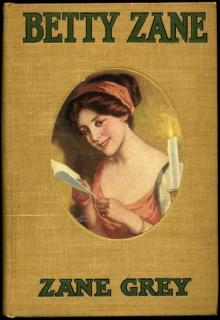 Betty Zane
Betty Zane Riders of the Purple Sage
Riders of the Purple Sage The Second Zane Grey MEGAPACK®
The Second Zane Grey MEGAPACK® The Rainbow Trail
The Rainbow Trail The Man of the Forest
The Man of the Forest The Mysterious Rider
The Mysterious Rider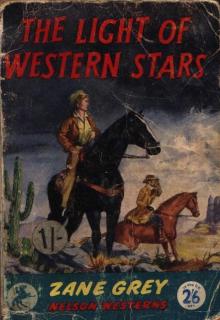 The Light of the Western Stars
The Light of the Western Stars The Last of the Plainsmen
The Last of the Plainsmen Collected Works of Zane Grey
Collected Works of Zane Grey The Call of the Canyon
The Call of the Canyon Twin Sombreros
Twin Sombreros The Dude Ranger
The Dude Ranger The Water Hole
The Water Hole Raiders of Spanish Peaks
Raiders of Spanish Peaks West of the Pecos
West of the Pecos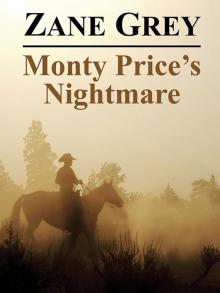 Monty Price's Nightmare
Monty Price's Nightmare Stairs of Sand
Stairs of Sand Rogue River Feud
Rogue River Feud Union Pacific
Union Pacific The Western Romance MEGAPACK ®: 20 Classic Tales
The Western Romance MEGAPACK ®: 20 Classic Tales The Lone Star Ranger
The Lone Star Ranger The Zane Grey Megapack
The Zane Grey Megapack Shadow on the Trail
Shadow on the Trail The Vanishing American
The Vanishing American The Trail Driver
The Trail Driver War Comes to the Big Bend
War Comes to the Big Bend The Westerners
The Westerners Silvermane
Silvermane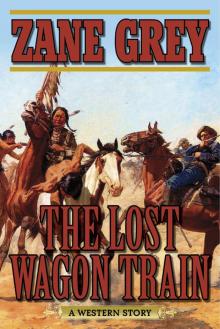 The Lost Wagon Train
The Lost Wagon Train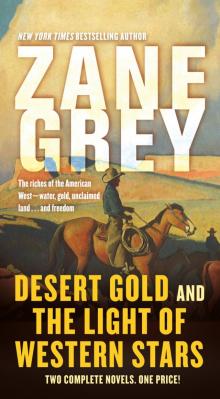 Desert Gold and the Light of Western Stars
Desert Gold and the Light of Western Stars Wildfire and the Heritage of the Desert
Wildfire and the Heritage of the Desert The Great Trek
The Great Trek Cabin Gulch
Cabin Gulch Code of the West
Code of the West Sunset Pass
Sunset Pass Panguitch
Panguitch The Drift Fence
The Drift Fence Dorn Of The Mountains
Dorn Of The Mountains Desert Heritage
Desert Heritage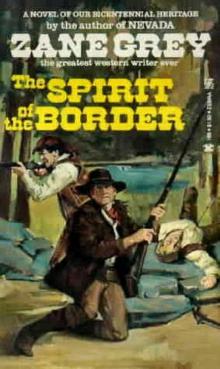 The Spirit Of The Border
The Spirit Of The Border Buffalo Stampede
Buffalo Stampede The Hash Knife Outfit
The Hash Knife Outfit The Lone Star Ranger and the Mysterious Rider
The Lone Star Ranger and the Mysterious Rider The Shepherd of Guadaloupe
The Shepherd of Guadaloupe Riders of the Purple Sage (Leisure Historical Fiction)
Riders of the Purple Sage (Leisure Historical Fiction) Thunder Mountain
Thunder Mountain The Spirit of the Border and the Last Trail
The Spirit of the Border and the Last Trail The Day of the Beast
The Day of the Beast The Heritage of the Desert
The Heritage of the Desert The Deer Stalker
The Deer Stalker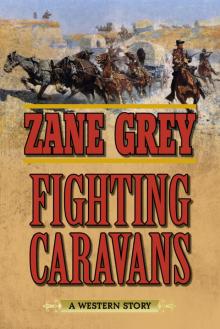 Fighting Caravans
Fighting Caravans